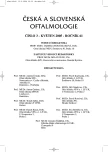Terson’s Syndrome, Pars Plana Vitrectomy and Anatomical and Functional Outcome
Authors:
J. Štěpánková 1; J. Dvořák 2; D. Dotřelová 1; E. Klofáčová 2
Authors‘ workplace:
Oční klinika dětí a dospělých UK 2. LF a FN Motol, Praha
přednosta doc. MUDr. Dagmar Dotřelová, CSc.
1; Oční klinika VFN a 1. LF UK, Praha
přednosta doc. MUDr. Bohdana Kalvodová, CSc.
2
Published in:
Čes. a slov. Oftal., 61, 2005, No. 3, p. 179-184
Overview
The retrospective case review was aimed to demonstrate anatomical and functional results of pars plana vitrectomy (PPV) in patients with Terson’s syndrome (TS). The most common cause of TS was an acute subarachnoid hemorrhage of ruptured intracranial aneurysm (6 eyes). One patient suffered traumatic subdural and subarachnoid hemorrhage. PPV was performed in 7 eyes of 6 patients (2 women and 4 men). The patients ranged in age from 18 to 53 years (average 37.5 year), the mean age was 37.5 years. The interval between intracranial hemorrhage and PPV varied from 2 to 12 month (average 7.5 months). The visual acuity postoperatively improved in all 7 eyes.The mean period of observation was 12.5 month. Intraoperative complications included retinal break (1) only. Late complications included epiretinal membrane (2), glaucoma (1), cataract (2) and conjunctival cyst (1). Pars plana vitrectomy is highly effective and relatively safe method in hastening visual rehabilitation of adults with Terson’s syndrome.
Key words:
Terson’s syndrome, intracranial hemorrhage, pars plana vitrectomy
Labels
OphthalmologyArticle was published in
Czech and Slovak Ophthalmology

2005 Issue 3
Most read in this issue
- Terson’s Syndrome, Pars Plana Vitrectomy and Anatomical and Functional Outcome
- Congenital Stationary Night Blindness (CSNB) – a Case Report
- Spontaneous Late Subluxation of Capsule, Intraocular Lens and Capsular Ring in Patient with Pseudoexfoliation Syndrome – a Case Report
- Perforating Pars Plana Sclerotomy in Idiopathic Uveal Effusion Syndrome
